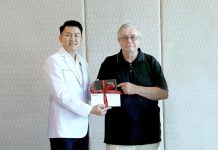Surgeons can be the ‘prima donnas’ of medicine, if you like. It is the surgeons who get the headlines in the newspapers. It is the surgeons who are the stars in movies and TV. Who can remember the irascible surgeon Sir Lancelot Spratt (Dr. In The House, 1954) or the young surgeon Dr. Kildare (1961)? Slightly more recent, the American surgeons in M*A*S*H?
However, surgeons have been around for many centuries and have their own Royal College. The origins of the first Royal College of Surgeons go back to the fourteenth century with the foundation of the ‘Guild of Surgeons Within the City of London’. There was dispute between the surgeons and barber surgeons until an agreement was signed between them in 1493, giving the fellowship of surgeons the power of incorporation. In 1745 the surgeons broke away from the barbers to form the Company of Surgeons. In 1800 the Company was granted a Royal Charter to become the Royal College of Surgeons in London. A further charter in 1843 granted it the present title of the Royal College of Surgeons of England (of which I proudly say I am a member).
We marvel at the surgical advances in the past century, but while I take my hat off to the surgeons, the real praise goes to the anesthetists. Without the advances in anesthetics, brawny assistants would still be holding patients down while surgeons attacked with scalpels and saws and the patient lay there biting on a bullet.
The first anesthetic agent was ether, dribbled on to a mask to knock the patient out and allow the surgeon to take his time and become meticulous in his approach. The first public demonstration of ether anesthesia took place on 16 October 1846, at Massachusetts General Hospital in Boston. The anesthetist was William Morton and the surgeon was John Warren; and the operation was the removal of a lump under the jaw of a Gilbert Abbott.
While there have been enormous advances since then, I can remember being a medical student and assisting at an operation in outback Australia in 1964. The anesthetic was ether, dribbled on to the patient’s gauze mask by the matron of the public hospital, and it was a Caesarian section for twins. There was no air-conditioning and it was 43 degrees in the theatre, where the fumes were making us all woozy. Amazingly everyone survived the ordeal, mother, twin sons, the local doctor, the matron and me.
Despite outback Australia, anesthesia progressed in the rest of the world. Chloroform was introduced by James Simpson, the Professor of Obstetrics in Edinburgh, in November 1847. This was a more potent agent but it had more severe side effects, including sudden death. However, it worked well and was easier to use than ether and so, despite its drawbacks, became very popular.
The next major advance was the introduction of local anesthesia – cocaine – in 1877. Things definitely did go better with ‘coke’! Then came local infiltration, nerve blocks and then spinal and epidural anesthesia, which in the 1900s allowed surgery in a relaxed abdomen, and is still used today, especially in obstetric anesthesia, where the mother can be anaesthetized, without the baby being affected as well.
The next important innovation was the control of the airways with the use of tubes placed into the trachea. This permitted control of breathing and techniques introduced in the 1910s were perfected in the late 1920s and early 1930s. Then came the introduction of intravenous induction agents. These were barbiturates which enabled the patient to go off to sleep quickly, smoothly and pleasantly and therefore avoided any unpleasant inhalational agents. Then in the 1940s and early 1950s, there came the introduction of muscle relaxants, firstly with curare (the South American Indian poison, but not administered by native blowpipe) and then agents less dangerous.
Anesthesia is now very safe, with mortality of less than 1 in 250,000 directly related to anesthesia. Nevertheless, with today’s sophisticated monitoring systems and a greater understanding of bodily functions, the anesthetic profession will continue to strive for improvement over the next 150 years.”
On behalf of all patients requiring surgery in the future I thank the anesthetists. No longer do they have to bite on this bullet!




